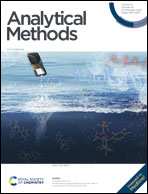A highly sensitive fluorescent nanoprobe for the amplified detection of formaldehyde†
Abstract
Non-conjugated polymer nanoparticles (PNPs) have been widely reported for analytical applications; however, the development of an effective fluorescence signal-amplification scheme based on PNPs remains challenging. In this study, polyethyleneimine-based polymer nanoparticles (PEI-PNPs) were synthesized for interrogating the fluorescence signal-amplification analytical application of the PNPs. The PEI-PNPs with an aggregated PEI polymer structure were able to confine a large density of sub-fluorophores on an individual nanoparticle, enabling the realization of a signal-amplification effect. Herein, formaldehyde (FA) was utilized for enhancing the fluorescence intensity of the PEI-PNPs as a model to confirm our proof-of-concept strategy. Our results showed that a more than 9-fold signaling-enhancing ability for the sensing of FA was observed using the PEI-PNPs prepared with a higher PEI concentration. The possible mechanism for the FA amplified sensing was studied. In particular, the FA-recognition units were sub-fluorophores of PEI-PNPs, which were simultaneously formed with the preparation of the PEI-PNPs avoiding the leakage effect of dyes. We believe that the water-soluble and biocompatible PEI-PNPs are promising candidates for the detection of endogenous FA in living systems.



 Please wait while we load your content...
Please wait while we load your content...